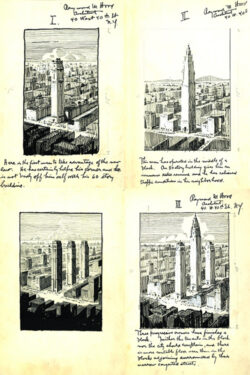Hood loved towers. In both his built work and visionary urbanism, he championed the tower as the ideal form for the skyscraper. Instead of the mountainous setbacks envisioned by Corbett and Ferriss, Hood imagined slender shafts soaring above expansive open spaces-a “modern city of sunlight, air, and free circulation.” He first articulated this idea in 1924 in The New York Times article “City of Needles,” and he continued to promote the concept in numerous places in 1926-1929 in response to the contemporary debate among New York architects and planners over the skyscraper and congestion.
In the drawings prepared for the article “Tower Buildings and Wider Streets,” Hood outlined his response to the growing problem of traffic congestion in midtown Manhattan. He proposed replacing the existing buildings with tall, slender towers surrounded by streets. Pen-and-ink drawings, probably by Hood himself, illustrate his plans for the gradual transformation of a typical block.
Fundamentally altered, the historic grid would be replaced by a repeating pattern of two or three towers per block, with fourteen times the amount of street space. Integral to Hood’s solution was a proposal to create incentives for developers to build on a smaller percentage of their lots. His new formula proposed a limit on volume based on street frontage: the developer could build a fixed amount higher for each foot that the building was set back from the lot line.
Stressing practicality, Hood thought his plan would befit all parties: increased volume (and rentable space) for the developer; more light and air for the tower’s occupants; and more street space for the public.
Hood was fascinated with the idea of residential skyscraper bridges, which he believed could both help solve the problems of traffic congestion and offer an ideal lifestyle on the waterfront. His first proposal appeared in an article in The New York Times Magazine in February 1925, illustrated with a drawing by Hugh Ferriss. Hood described a great bridge across the Hudson River ten thousand feet long, where the supporting pylons were apartment buildings of 50 or 60 stories. There would eventually be dozens of these luxury waterside communities for fifty thousand residents, he predicted. Hood reprised the proposal in a 1926 article in the magazine Liberty, describing the bridges as 20,000 feet long, with a center road beds as wide as Park Avenue and predicted that there would be twenty, forty, a hundred of them.
Learn more in the City of The Future virtual exhibition.
Carol Willis
Carol Willis is the founder and director of the Skyscraper Museum and a professor of Urban Studies at Columbia University’s Graduate School of Architecture, Preservation and Planning. She is also the author of Form Follows Finance and co-author of Building the Empire State with Donald Friedman.
